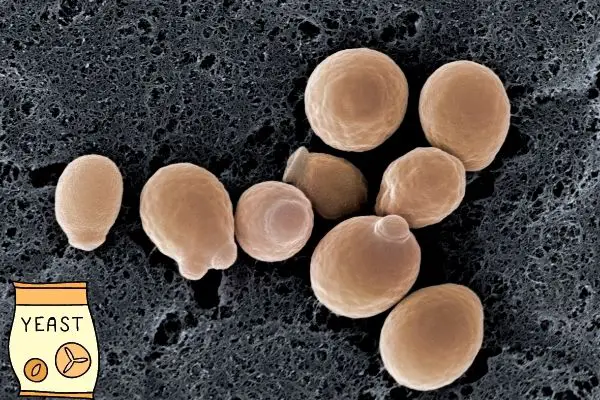Can you use ale yeast for mead? The simple answer is yes, you can use ale yeast for mead. However, the process and results may vary compared to using traditional wine or mead yeast.
As an experienced brewer, I have tried numerous yeast strains for making mead, and ale yeasts have consistently produced interesting and quite good results.
My favorite is the Kveik Ale yeast strain from Norway that produces a fresh and flavorful mead.
In this blog post, I will share my personal experiences and provide helpful tips on using ale yeast for mead.
Let’s go!
Ale Yeast vs. Wine Yeast for mead
Before we delve into using ale yeast for mead, let’s discuss the differences between ale yeast and wine yeast.
The reason for this is, that wine or champagne yeasts are most often the first choice by mead makers as these give a fairly clean taste and ferment to high ABV percentages.

Ale yeast, typically used for brewing beer, ferments at a faster rate and generates more fruity esters and phenolic compounds, which can contribute to unique flavors and aromas in the final product.
Wine yeast, on the other hand, ferments slower and generally produces cleaner flavors with fewer esters and phenols.
When it comes to mead, using ale yeast can produce a more complex and fruity final product, while wine yeast may yield a cleaner, more straightforward mead.
Choosing the Right Ale Yeast for Mead
There are numerous ale yeast strains available, and each strain can produce different results when used for mead. Here are some popular ale yeast strains that I’ve had success with:
Safale US-05
This American ale yeast is known for its clean and neutral fermentation profile, making it an excellent choice for a more traditional mead with minimal esters or phenols.
Safale S-04
This English ale yeast produces more fruity esters than US-05, lending a unique character to the mead. It’s an excellent choice for a melomel (fruit mead) or metheglin (spiced mead).
Wyeast 1318 London Ale III
This strain is known for its high ester production and low attenuation, resulting in a sweet and fruity mead. It works well with fruit-forward melomels and adds a pleasant complexity to traditional meads.
Lallemand Voss Kveik Ale Yeast
Kveik is a Norwegian yeast strain that has been used for thousands of years to prepare traditional farmhouse ales in Norway.
I produces a deep ale profile with notes of fruits and citrus that does quite well with the sweetness of mead.
LalBrew Voss Kveik™ is an original, traditional dried yeast variety from Sigmund Gjernes from Voss, Norway that has been maintaining this yeast culture since the 1980s using traditional methods and generously shared it with the wider brewing community.
LalBrew Voss™ is suitable for fermentation at a wide range of temperatures, from 25 – 40°C (77 – 104°F), with an optimal range of 35 – 40°C (95 – 104°F). It ferments very quickly within the optimal temperature range, typically reaching full attenuation in 2-3 days.
Preparing Your Ale Yeast for Mead
Properly preparing and pitching your ale yeast is crucial for a successful mead fermentation. Here are some tips to get started:
1. Rehydrate dry yeast: If using dry ale yeast, rehydrate it according to the manufacturer’s instructions before pitching. This will help ensure a healthy and active yeast population.
2. Create a yeast starter: For liquid ale yeast, creating a yeast starter can help ensure a strong and healthy fermentation. A yeast starter is a small batch of wort or must that you pitch your yeast into before adding it to the main batch. This helps the yeast population grow and acclimate to the sugar-rich environment.
3. Aerate the must: Oxygen is essential for yeast growth and activity, so be sure to aerate your must before pitching the yeast. This can be done by shaking the fermenter or using a sanitized whisk to vigorously stir the must.
4. Control fermentation temperature: Ale yeast strains have different temperature ranges for optimal fermentation. Be sure to maintain the appropriate temperature for your chosen strain to ensure a successful fermentation.
Fermentation Considerations
When using ale yeast for mead, there are some fermentation considerations to keep in mind:
1. Fermentation time: Ale yeast typically ferments faster than wine yeast, so be prepared for a shorter fermentation period. However, this can vary depending on the yeast strain and fermentation conditions.
2. Nutrient requirements: Ale yeast may require additional nutrients, such as yeast nutrient or yeast energizer, to ensure a healthy fermentation. Be sure to follow the manufacturer’s recommendations for nutrient additions.
3. Monitoring fermentation: Keep an eye on your fermentation, checking for signs of activity such as airlock bubbles and krausen formation. If the fermentation appears to be sluggish or stalled, consider adding more nutrients or adjusting the temperature.
Aging and Conditioning Your Mead
Mead made with ale yeast may require a longer aging period to reach its full potential. This is because the fruity esters and phenols produced by ale yeast can take time to mellow and integrate with the mead’s flavors.

Be patient and allow your mead to age for several months or even years to achieve the best results.
How do I know what yeast is right for me?
When choosing yeast for mead, it’s important to consider the characteristics you desire in your final product. Different yeast strains can impart various flavors, aromas, and fermentation profiles. Here are a few factors to consider when selecting a yeast for mead:
1. Fermentation characteristics: Determine whether you want a dry, semi-sweet, or sweet mead. Different yeast strains have varying levels of alcohol tolerance and fermentation capabilities, which impact the residual sweetness of the mead.
2. Flavor profile: Some yeast strains contribute unique flavors and aromas during fermentation. For example, certain strains can produce fruity, floral, or spicy notes that can enhance the overall character of the mead.
3. Temperature tolerance: Consider the temperature at which you plan to ferment your mead. Some yeast strains are more suitable for cooler temperatures, while others thrive in warmer conditions. Ensure that the yeast you choose can handle the fermentation temperature range you have in mind.
4. Nutrient requirements: Yeast needs nutrients to thrive during fermentation. Some strains have higher nutrient demands, while others are more resilient with fewer nutrient additions. Understanding the nutrient requirements can help you properly nourish the yeast during fermentation.
It’s advisable to research and experiment with different yeast strains to find the one that aligns with your desired flavor profile and fermentation goals.
Additionally, consulting with experienced mead makers or joining mead-making communities can provide valuable insights and recommendations based on their experiences.
Final Thoughts
In conclusion, using ale yeast for mead can produce unique and complex flavors that may not be achievable with traditional wine or mead yeast.
By choosing the right ale yeast strain, properly preparing and pitching the yeast, and monitoring the fermentation process, you can create a delicious mead with a distinct character. Here are some key takeaways:
1. Ale yeast can be used for mead, producing unique flavors and aromas.
2. Different ale yeast strains will yield different results in mead.
3. Properly prepare and pitch your ale yeast for a successful fermentation.
4. Fermentation with ale yeast may be faster than with wine yeast.
5. Additional nutrients may be required for ale yeast fermentation.
6. Monitor fermentation and make adjustments as needed.
7. Mead made with ale yeast may require a longer aging period.
8. Experiment with different ale yeast strains to find the best fit for your mead.
9. Aerate the must to ensure a healthy yeast population.
10. Control fermentation temperature for optimal results.
Happy mead-making!
FAQs
What kind of yeast should I use for mead?
For making mead, it is generally recommended to use wine yeast strains, specifically those that can tolerate high alcohol levels. Some popular choices include Lalvin D-47, Lalvin K1-V1116, and Red Star Premier Blanc. These yeast strains are known for their ability to ferment honey into mead while producing desirable flavors and aromas.
Is ale similar to mead?
No, ale is not similar to mead at all. Ale is a type of beer that is brewed using malted barley, water, yeast, and hops. It has a distinct bitter taste and is fermented. Mead, on the other hand, is an alcoholic beverage made by fermenting honey with water and sometimes with the addition of fruits, spices, grains, or hops. It has a sweet taste and is often referred to as honey wine. So, while both are alcoholic beverages, they are made using different ingredients and have different flavor profiles.
What does mead compare to?
Mead can be compared to wine or beer in terms of alcoholic beverages. It shares similarities with wine due to its fermentation process using honey, and it can also resemble beer in terms of its carbonation and flavor profiles.
How do you pick yeast for mead?
When selecting yeast for mead, it is important to consider the desired flavor profile and fermentation characteristics. Different yeast strains can produce varying levels of alcohol, sweetness, and esters, which can greatly influence the final product. Some popular yeast options for mead include Lalvin D-47, Lalvin EC-1118, and Wyeast 4184. It is recommended to choose a yeast that complements the honey flavors and desired outcome of your mead recipe.







